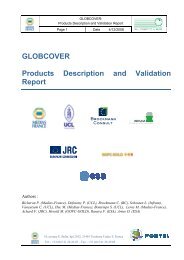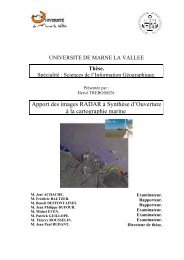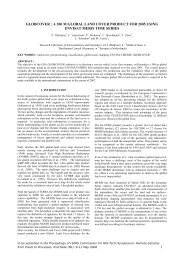Medspiration â System Requirements Document - Data User Element
Medspiration â System Requirements Document - Data User Element
Medspiration â System Requirements Document - Data User Element
Create successful ePaper yourself
Turn your PDF publications into a flip-book with our unique Google optimized e-Paper software.
<strong>Medspiration</strong><br />
MED-SOC-RS-001_1<br />
<strong>System</strong> <strong>Requirements</strong> <strong>Document</strong><br />
Issue F<br />
measured by an infrared radiometer operating in the 10 – 12 µm waveband.<br />
Physically it represents the temperature of the water at a depth of approximately 10 –<br />
20 µm.<br />
• SSTsubskin represents the temperature at the base of the thermal skin layer. The<br />
thermal skin layer is a region less than 1 mm deep in which the convective exchange<br />
of heat by turbulent mixing is inhibited by the proximity of the sea surface, so that the<br />
net outward flow of heat through the surface creates a steep reduction of temperature<br />
towards the surface. Below the skin layer, turbulent processes ensure that the<br />
temperature is nearly uniform over a depth of at least a few centimetres. By<br />
definition within GHRSST-PP this corresponds to the SSTsubskin temperature. In<br />
practice SSTsubskin is assumed to be approximately equal to the radiometric<br />
temperature measured by a microwave radiometer operating in the 6-11 GHz<br />
frequency band, although the relationship is not exact or fully known.<br />
• SSTdepth is the generic term used to represent the temperature measured by a<br />
contact thermometer within the upper few metres of the water column and generally<br />
referred to as the “bulk” SST. If the water column below the skin layer is uniform<br />
(typically the case at night and when wind mixing is strong) then SSTdepth is the<br />
same as SSTsubskin, irrespective of the actual depth of the measurement (see<br />
Figure 2-1a). However, when daytime solar shortwave radiation penetrates to heat<br />
the water below the skin layer, and if wind mixing is weak, stable stratification<br />
develops in the upper few metres of the water column, in which the temperature<br />
increases towards the sea surface (apart from the cool skin layer which lies right at<br />
the surface - see Figure 2-1b). This phenomenon is called a diurnal thermocline.<br />
When it occurs a measurement of SSTdepth, made from a buoy or ship-mounted<br />
thermometer which does not precisely specify the sampling depth, is of limited value.<br />
A diurnal thermocline almost always collapses to a uniform temperature some time<br />
after sunset when surface cooling removes the excess heat. Under calm conditions,<br />
however, it may take several hours for the diurnal thermocline to decay entirely.<br />
• SSTfnd is defined within GHRSST-PP as the temperature at the base of the diurnal<br />
thermocline. It is so named because it represents the foundation temperature on<br />
which the diurnal thermocline develops during the day. SSTfnd changes only<br />
gradually along with the upper layer of the ocean, and by definition it is independent<br />
of skin SST fluctuations due to wind- and radiation-dependent diurnal stratification or<br />
skin layer response. It is therefore updated at intervals of 24 hrs. SSTfnd<br />
corresponds to the temperature of the upper mixed layer which is the part of the<br />
ocean represented by the top-most layer of grid cells in most numerical ocean<br />
© 2004 SOC Page 15 of 193








